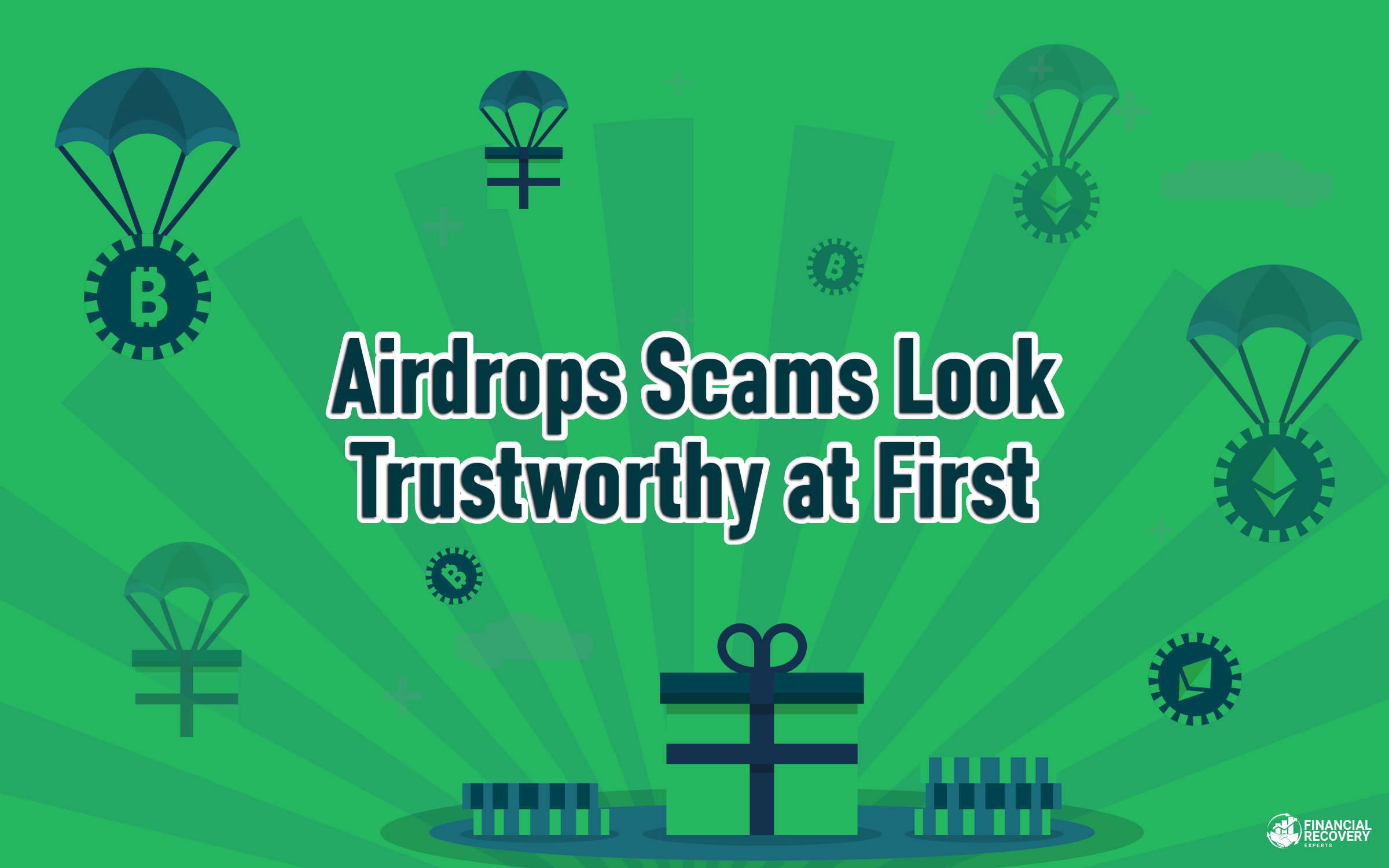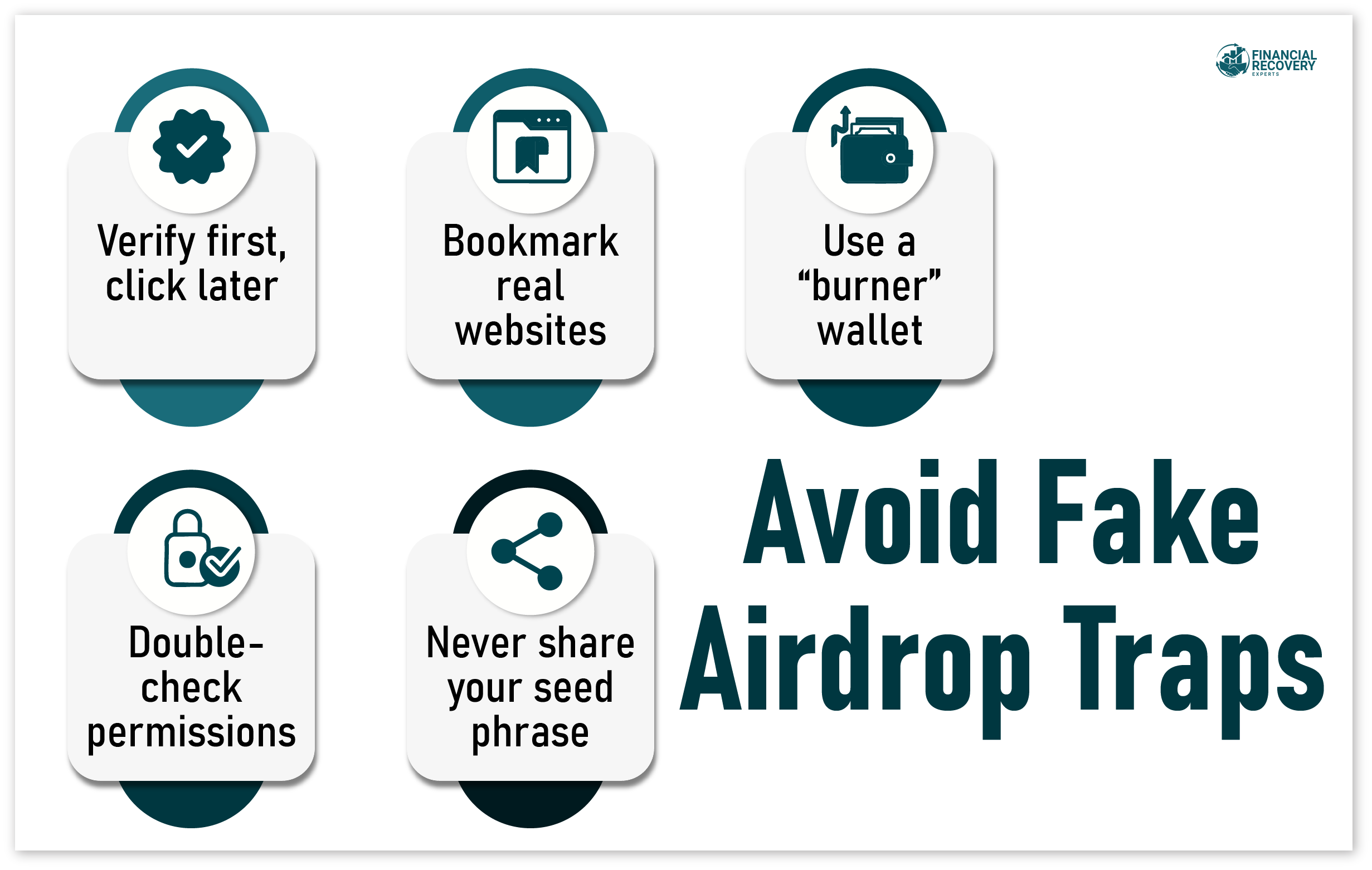
- Crypto
- August 4, 2025
Free airdrops sound like an easy win, especially when the crypto market is filled with new projects. But that promise of “free money” often hides something dangerous: phishing campaigns designed to steal your crypto wallet details and drain your funds.
Fake airdrops aren’t just random spam. They’re part of a growing problem that cost crypto users over $1 billion in phishing-related losses in 2024 alone, according to Chainalysis. With more than 420 million people worldwide now involved in crypto, scammers have more chances than ever to trick even careful investors.
Moreover, scammers know how to make their traps look real, copying logos, running ads, and even hacking real accounts to share fake airdrop links. Many victims don’t realize what happened until it’s too late. Even experienced users fall for these scams when fake airdrops show up during big project launches or market excitement.
In this article, we’ll explore why these scams work so well, how scammers set their traps, and what practical steps you can take to keep your crypto safe.
What Exactly Is a Crypto Airdrop?
A real crypto airdrop is a way for new projects to get attention and reward early supporters. It’s basically free tokens sent to users to build a community before the coin officially launches on exchanges.
You might get tokens by:
- Holding a certain cryptocurrency like Ethereum or Bitcoin at a set date
- Signing up for the project’s official website and sharing your wallet address.
- Joining and engaging in the project’s social media groups to help promote it.
Real airdrops never ask for your private key, seed phrase, or payment. They’re meant to introduce a new project, build trust, and get more people involved before trading begins.
These airdrops help projects grow quickly by turning early users into community members and promoters. But sadly, scammers use this idea to trick people into handing over wallet details.
How Fake Airdrops Began?
The idea of airdrops originated as a simple and honest concept. Crypto projects would send free tokens to early users or anyone holding coins like Ethereum or Bitcoin. It was a smart way to reward loyal users and spread the word before launching on big exchanges.
But as the idea got popular, scammers noticed two big opportunities. They knew two things: most people love free crypto, and many don’t fully understand how wallets or private keys work.
So they set traps by:
- Copying real project websites and logos so everything looks official.
- Asking for private keys or seed phrases by claiming it’s needed to get the tokens.
- Making fake contracts to sign that secretly allow scammers take your coins later.
What started as a fun giveaway turned into a common scam. And because fake airdrops look so real, even careful users sometimes fall for them.
Scammers Build Your Trust And Betray It

Scammers know that before they can steal your crypto, they have to win your trust, at least for a moment. Here’s how they carefully create that false sense of safety before turning it against you.
1. They look authentic
Scammers don’t just make quick, fake websites anymore. They copy real project sites in detail using the same colors, logos, and writing style. Some even set up fake social media accounts with real-looking posts and followers. Sometimes, they hack verified Twitter or Telegram accounts to share fake airdrop links, making the scam look completely legit and difficult to notice.
2. They create hype
Fake airdrops often exploit urgency to prompt people to act hastily without thinking. You might see messages like “Only for the first 5,000 users!” or “Just 2 hours left to claim!” These countdowns play on the fear of missing out and make people skip the checks they’d normally do. When combined with flashy graphics and big numbers, it becomes very tempting to act immediately without thinking.
3. They mix real and fake details
To look trustworthy, scammers cleverly combine real information from genuine projects. Like actual team member names, whitepapers, and even old announcements with fake promises of giveaways. This blend of real and fake makes the scam harder to spot at first glance. Many victims believe it must be legitimate because the details seem familiar. Without realizing that scammers simply copy publicly available information to build fake credibility.
4. They target community spaces
They join safe channels such as Telegram groups, Discord servers, and cryptocurrency forums where genuine investors chat. They pretend to be moderators or project representatives and post false airdrop URLs directly to the users who already have faith in the channel. Some even wait for moments of real announcements or hype to blend in, making it harder for members to tell what’s real and what’s planted by scammers.
Top 7 Common Tactics Used in Fake Airdrops

Fake airdrops don’t just pop up by chance. Scammers have their own tricks they use again and again. They mix a bit of tech with psychological pressure to make these offers look real and safe.
- Asking for private keys or seed phrases: The most dangerous trick. Scammers build sites where you “claim” your tokens by typing in your seed phrase. This is like giving them the keys to your safe.
- Fake wallet connect: Some scam sites ask you to connect your wallet. But instead of connecting safely, it quietly signs hidden transactions. This lets scammers take your coins without you noticing right away.
- Fake smart contracts: They ask you to sign a contract that’s supposed to release your tokens. But hidden in the contract are permissions that let scammers move your funds later.
- Lookalike social media accounts: Scammers make Twitter, Telegram, or Discord accounts that look just like real team members. Same pictures and almost the same names. Then they share fake airdrop links that seem trustworthy.
- Clone websites: They build websites that look almost exactly like real project sites but change one small thing in the address, like an extra letter or a missing dash. At a glance, it seems real, but it’s a trap.
- Private messages in groups: Sometimes scammers won’t wait for you to find them. They send you a direct message on Telegram or Discord, saying there’s a “special” airdrop just for loyal users. This makes it feel personal and more believable.
- Fake influencer giveaways: They post fake messages or ads claiming a popular influencer is giving away tokens. They might even show edited screenshots to make it look real. But the link leads straight to a scam.
Beyond Tokens: The Bigger Danger
Fake airdrops aren’t just about stealing what you have in your wallet right now. Once scammers get hold of your private key or seed phrase, they can do a lot more damage:
- Drain any new tokens you add later, even months from now, as soon as something hits your wallet, it’s gone.
- Sell your wallet details on dark web forums, so even more scammers can target you.
- Use your wallet address to run phishing scams on your friends or contacts, making it look like it’s coming from someone they trust.
- Track your wallet activity to find the best moment to strike again when your balance goes up.
- Link your wallet to other personal data they’ve collected online, making you a bigger target for future scams.
The worst part is that sometimes individuals do not even notice they’ve been hit until weeks later. They notice new coins appearing in their wallet, get thrilled, and then see them vanish within a very short time. It’s a slow trap that keeps hurting long after the first mistake.
Real-World Examples You Should Know

These scams aren't something you hear on the internet; they've actually occurred with actual people and real projects. Below are some examples that demonstrate just how simple it is for fraudulent airdrops to dupe even cautious crypto users.
Case 1: The Fake Uniswap Airdrop
When Uniswap, a popular decentralized exchange, announced a real airdrop in 2020, scammers quickly set up copycat websites. These fake sites asked users to enter seed phrases to “claim” UNI tokens, and thousands of users lost money within days.
Case 2: Copycat Telegram Bots
Fake bots on Telegram promised instant airdrops for chatting with them. They asked users to “verify” wallets by typing in private keys. Many users, thinking it was automated and safe, complied and lost their tokens immediately.
Case 3: Sponsored Ads on Social Media
Some scammers even paid for ads on Facebook, Instagram, and Google. The ads led to professional-looking phishing sites. Victims trusted them because they appeared as sponsored results at the top of search pages.
5 Simple Ways to Avoid Fake Airdrop Traps

Knowing about these scams isn’t enough; it’s also about being careful whenever you use your wallet. Here are some easy steps you can take to keep your crypto safe from fake airdrops
1. Verify first, click later:
Before you click on any Airdrop link, pause and inspect where it actually came from. Check for official website links or actual social media pages managed by the project. Scammers rely on quick clicks, so slowing down to check can stop you from losing your tokens.
2. Bookmark real websites:
Fake advertisements and copycat sites tend to appear first when you search online. To avoid these, save the official project website as a bookmark in your browser. Using your bookmark instead of searching helps make sure you always land on the real, trusted website every time.
3. Use a “burner” wallet:
Keep your main crypto safe by creating a separate wallet just for testing new airdrops or sites. If something goes wrong, only the smaller balance in your burner wallet is at risk. It’s a simple step that helps protect your main funds from unexpected scams.
4. Double-check permissions:
Sometimes, by mistake, you might give sites permission to move tokens from your wallet. Use tools to see which apps or contracts can access your tokens. Removing anything suspicious helps keep scammers from draining your wallet later on.
5. Never share your seed phrase:
Your seed phrase unlocks everything in your wallet. Real crypto projects, support teams, or admins will never ask for it. If anyone does, it’s always a scam. Keep your seed phrase private and never type it into any website, chat, or unknown app, no matter what.
What to Do If You Have Been Scammed?
If you’ve already sent money, reach out to your bank or crypto exchange right away. Sometimes they can block or trace the transaction if you act quickly. Also, stop talking to the scammer immediately. Block them and leave any group or chat they control. The longer you stay in touch, the more they’ll try to keep convincing you.
Take screenshots of everything: chats, wallet addresses, and transaction receipts. These can help if you file a police report or contact cybercrime units. In some cases, if you move fast enough, a transaction might even be reversed.
Report what happened to the FTC at ReportFraud.ftc.gov and to the FBI’s Internet Crime Complaint Center (IC3). They collect these reports and help track down scammers. Some recovery services, like Financial Recovery Expert, can also guide you through the process and help recover your lost money.
Staying Safe in Crypto Communities
Crypto is built on trust, but scammers are working full-time to break it. Fake airdrops are clever, professional-looking traps set by people who understand how human nature works.
Before you click “Claim,” remember this: real projects don’t need your seed phrase, don’t ask you to pay upfront, and don’t rush you into a decision. By learning how these scams operate, you protect not just your wallet but your friends and the broader crypto community.
Stay skeptical, double-check everything, and protect your wallet like it holds more than coins because it does. It holds your financial freedom.
Victim of a fake Phishing Airdrop scam?
Get expert guidance and explore your recovery options with Financial Recovery Experts. Don’t wait, call now and take the first step to protect your funds.
FAQs (Frequently Asked Questions)
It’s a scam that looks like a free token giveaway from a real project. Scammers copy logos and sites to fool you into sharing your private key, seed phrase, or signing a fake contract. Once they get access, they can drain your wallet anytime.
Yes. Even without your seed phrase, scammers can trick you into connecting your wallet to a fake site or signing hidden transactions. This gives them permission to move tokens later, often without you noticing until it’s too late.
Look for announcements on the official website or verified social media pages. Real airdrops never ask for your private key or payment. Watch out for fake URLs with small changes like extra letters or missing dashes that can easily be missed.
Disconnect your wallet right away and move your funds to a new wallet. Revoke any suspicious permissions, keep screenshots of chats and sites, and report what happened to crypto exchanges or scam reporting platforms so others don’t get caught too.
No. Real airdrops from genuine projects can be safe if you’re careful. Always double-check details, never share your seed phrase, and use a separate “burner” wallet just for airdrops. Staying cautious makes it much harder for scammers to trick you.